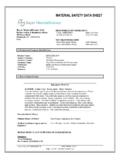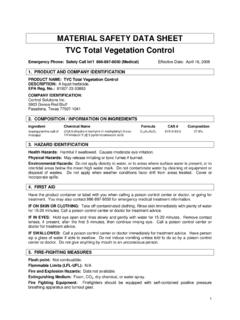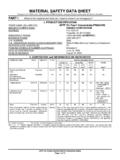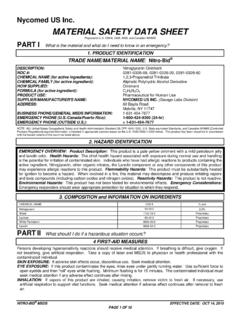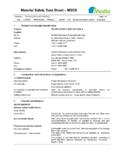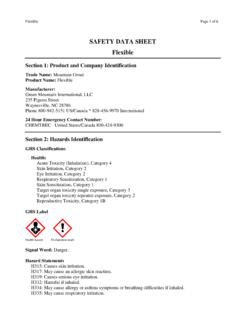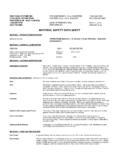Transcription of MATERIAL SAFETY DATA SHEET - BP
1 MATERIAL SAFETY data SHEET UNLEADED GASOLINE (UNBRANDED) Print Date: 05/19/2003 **FOR DISCLAIMER OF LIABILITY , SEE THE STATEMENT ON LAST PAGE** Page 1 of 8 IMPORTANT: Read this MSDS before handling and disposing of this product and pass this information on to employees, customers, and users of this product. 1. PRODUCT and COMPANY IDENTIFICATION MATERIAL Identity Unleaded Gasoline (Unbranded) Trade Name(s) None Other Name(s) Unleaded Motor Vehicle Gasoline, Unleaded Premium Gasoline, Unleaded Regular Gasoline or Petrol, Clear Gasoline. Chemical Description Petroleum Hydrocarbons Manufacturer s Address BP West Coast Products LLCC arson Business Unit 1801 E. Sepulveda Boulevard Carson, California 90749-6210 BP West Coast Products LLCC herry Point Business Unit 4519 Grandview Road Blaine, Washington 98230 Telephone Numbers Emergency Health Information: 1 (800) 447-8735 Emergency Spill Information: 1 (800) 424-9300 CHEMTREC (USA) 2.
2 COMPONENTS and EXPOSURE LIMITS Exposure Limits ACGIH OSHA Component1 CAS No. % Composition By Volume2 TLV PEL3 Units Type GASOLINE (2)(4) 8006-61-9 EQ 100 500 500 ppm STEL 300 300 ppm TWA which contains.
3 BENZENE (1)(2)(3)(4) 71-43-2 AP 1 to 5 5 ppm STEL 1 ppm TWA skin CYCLOHEXANE 110-82-7 LT 2 400 N/AP ppm STEL 300 300 ppm
4 TWA ETHYLBENZENE (2) 100-41-4 AP 1 to 3 125 125 ppm STEL 100 100 ppm TWA HEXANE (N-HEXANE) 110-54-3 AP 2 to 5 50 50 ppm TWA skin TOLUENE 108-88-3 AP 7 to 14 N/AP 150 ppm STEL 50 100 ppm TWA skin TRIMETHYL BENZENE (ALL ISOMERS)
5 25551-13-7 LT 5 25 25 ppm TWA 1,2,4-TRIMETHYLBENZENE 95-63-6 AP 1 to 4 25 25 ppm TWA UNLEADED GASOLINE (UNBRANDED) MSDS No. APPC975 Ver. 1 Print Date: 05/19/2003 Page 2 of 8 2,2,4 TRIMETHYLPENTANE 540-84-1 AP 3 to 10 N/AP N/AP XYLENE 1330-20-7 AP 8 to 15 150 150 ppm STEL 100 100 ppm TWA which may contain: ETHANOL 64-17-5 AP 0 to 10 1000 1000 ppm TWA METHYL TERTIARY BUTYL ETHER (MTBE) (4) 1634-04-4 AP 0 to 15 40 N/AP ppm TWA 1 Carcinogen displayed after Component Name.
6 Listed by (1) NTP, (2) IARC, (3) OSHA, (4) Other 2 See Abbreviations on last page 3 The OSHA exposure limits were changed in 1993 due to a federal court ruling. ARCO has chosen to list the 1989 OSHA exposure limits in this document as they are generally more stringent and therefore more protective than the current exposure limits. (Refer to 29 CFR ). 3. HAZARD IDENTIFICATION IMMEDIATE HAZARDS DANGER HIGHLY FLAMMABLE! OSHA/NFPA Class IB flammable liquid. Keep away from heat, sparks, and open flame. Never siphon gas by mouth. Harmful if swallowed. Contains petroleum distillates. ASPIRATION HAZARD! If swallowed, do not induce vomiting since aspiration into the lungs may cause chemical pneumonia.
7 Obtain prompt medical attention. Prolonged or repeated liquid contact may cause irritation. High vapor concentrations (greater than 1000 ppm) may cause irritation to eyes and respiratory system and may cause dizziness and other nervous system effects. Generally, human exposures to gasoline are considerably lower than levels which have caused adverse health effects in animal studies or human case studies of gasoline misuse or abuse (such as gasoline sniffing). Adverse health effects are not expected to occur at exposure levels typically encountered in the use of gasoline as a motor fuel. Avoid breathing vapors or mists. Use only with adequate ventilation. Use as a motor fuel only. Do not use as a cleaning solvent, thinner or for other non-motor fuel use.
8 Wash hands thoroughly after handling. ACUTE HEALTH HAZARDS Routes of Exposure Signs and Symptoms Inhalation (Primary) Exposures at airborne concentrations well above the recommended exposure limits in Section 2 may cause irritation of the nose, throat, and lungs, headache, dizziness, drowsiness, confusion, loss of coordination, fatigue, nausea, labored breathing and irregular heartbeats. May lead to unconsciousness, convulsions, and possibly death. Eye Contact May cause some transitory eye irritation but not expected to cause prolonged or significant eye irritation. Skin Contact Moderate skin irritation may occur upon short-term exposure. May be absorbed and contribute to the acute inhalation health effects (see above).
9 Ingestion ASPIRATION HAZARD! This MATERIAL can enter the lungs during swallowing or vomiting and may cause acute lung inflammation and damage which in severe cases may be fatal. Ingestion may cause irritation of the mouth, throat and gastrointestinal tract leading to nausea, vomiting, diarrhea, and restlessness. May cause headache, dizziness, drowsiness, confusion, loss of coordination, fatigue, nausea and labored breathing. May lead to unconsciousness, convulsions, and possibly death. UNLEADED GASOLINE (UNBRANDED) MSDS No. APPC975 Ver. 1 Print Date: 05/19/2003 Page 3 of 8 Summary of Chronic Hazards and Special Health Effects Exposures at airborne concentrations well above the recommended exposure limits in Section 2 may aggravate medical conditions such as chronic respiratory diseases, cardiovascular disease, skin diseases, or blood disorders.
10 Prolonged/repeated exposures above the recommended exposure limits via skin contact, inhalation or ingestion of this MATERIAL may result in adverse dermal or systemic effects. Avoid prolonged or repeated overexposure. Contains benzene, a chemical known to cause cancer in humans. Repeated and prolonged overexposure to benzene vapors may cause leukemia, aplastic anemia, or other blood disorders, immunotoxicity, reproductive harm or fetal toxicity. Neurotoxic effects have been associated with n-hexane, a component of this MATERIAL upon prolonged or repeated overexposure. Generally, human exposures to gasoline are considerably lower than levels which have caused adverse health effects in animal studies or human case studies of gasoline misuse or abuse (such as gasoline sniffing).
